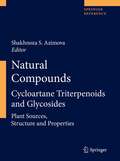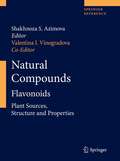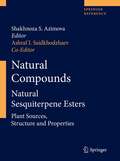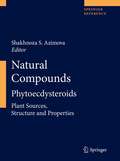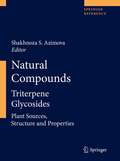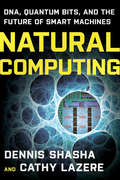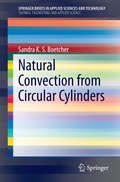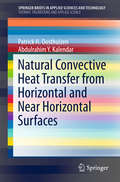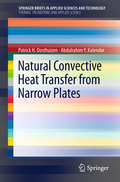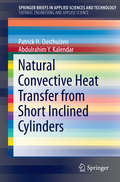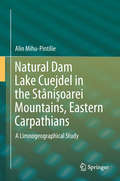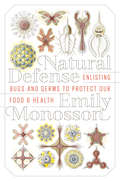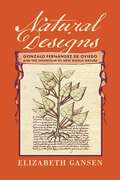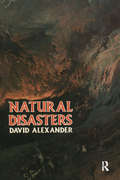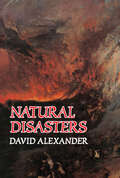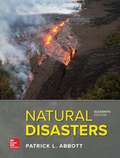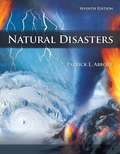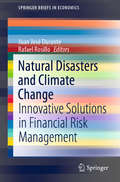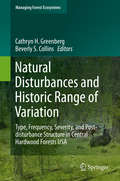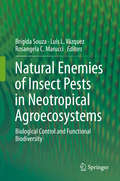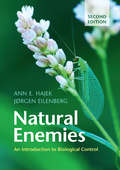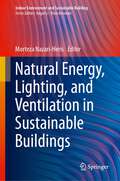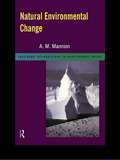- Table View
- List View
Natural Compounds: Cycloartane Triterpenoids and Glycosides
by Shakhnoza S. Azimova'Natural Compounds: Plant Sources, Structure and Properties' details the properties of over 7,500 chemical compounds of pharmacological interest found in plants. Each volume systematically covers occurrence of the compounds in plants, illustrations of chemical structures plus physical-chemical, spectral, and pharmacological data. Entries are indexed by plant name, subject, and pharmacological property. This provides unique coverage of information on compounds isolated from some 3,000 plants, including many from central Asia and Russia, that are not well known elsewhere. The entries for each compound share a similar format. The entries are preceded by tabulated information on the occurrence of the compounds in plants etc. The highly experienced team of compilers from the renowned Institute of the Chemistry of Plant Substances in Tashkent have expertly assessed the international literature and include data only when confident of its validity, e.g. excluding data where measurement processes cause degradation of the original compound.
Natural Compounds: Flavonoids
by Shakhnoza S. Azimova Valentina I. Vinogradova'Natural Compounds: Plant Sources, Structure and Properties' details the properties of over 7,500 chemical compounds of pharmacological interest found in plants. Each volume systematically covers occurrence of the compounds in plants, illustrations of chemical structures plus physical-chemical, spectral, and pharmacological data. Entries are indexed by plant name, subject, and pharmacological property. This provides unique coverage of information on compounds isolated from some 3,000 plants, including many from central Asia and Russia, that are not well known elsewhere. The entries for each compound share a similar format. The entries are preceded by tabulated information on the occurrence of the compounds in plants etc. The highly experienced team of compilers from the renowned Institute of the Chemistry of Plant Substances in Tashkent have expertly assessed the international literature and include data only when confident of its validity, e.g. excluding data where measurement processes cause degradation of the original compound.
Natural Compounds: Natural Sesquiterpene Esters. Part 1 and Part 2
by Shakhnoza S. Azimova Ashraf I. Saidkhodzhaev'Natural Compounds: Plant Sources, Structure and Properties' details the properties of over 7,500 chemical compounds of pharmacological interest found in plants. Each volume systematically covers occurrence of the compounds in plants, illustrations of chemical structures plus physical-chemical, spectral, and pharmacological data. Entries are indexed by plant name, subject, and pharmacological property. This provides unique coverage of information on compounds isolated from some 3,000 plants, including many from central Asia and Russia, that are not well known elsewhere. The entries for each compound share a similar format. The entries are preceded by tabulated information on the occurrence of the compounds in plants etc. The highly experienced team of compilers from the renowned Institute of the Chemistry of Plant Substances in Tashkent have expertly assessed the international literature and include data only when confident of its validity, e.g. excluding data where measurement processes cause degradation of the original compound.
Natural Compounds: Phytoecdysteroids
by Shakhnoza S. Azimova'Natural Compounds: Plant Sources, Structure and Properties' details the properties of over 7,500 chemical compounds of pharmacological interest found in plants. Each volume systematically covers occurrence of the compounds in plants, illustrations of chemical structures plus physical-chemical, spectral, and pharmacological data. Entries are indexed by plant name, subject, and pharmacological property. This provides unique coverage of information on compounds isolated from some 3,000 plants, including many from central Asia and Russia, that are not well known elsewhere. The entries for each compound share a similar format. The entries are preceded by tabulated information on the occurrence of the compounds in plants etc. The highly experienced team of compilers from the renowned Institute of the Chemistry of Plant Substances in Tashkent have expertly assessed the international literature and include data only when confident of its validity, e.g. excluding data where measurement processes cause degradation of the original compound.
Natural Compounds: Triterpene Glycosides. Part 1 and Part 2
by Shakhnoza S. Azimova'Natural Compounds: Plant Sources, Structure and Properties' details the properties of over 7,500 chemical compounds of pharmacological interest found in plants. Each volume systematically covers occurrence of the compounds in plants, illustrations of chemical structures plus physical-chemical, spectral, and pharmacological data. Entries are indexed by plant name, subject, and pharmacological property. This provides unique coverage of information on compounds isolated from some 3,000 plants, including many from central Asia and Russia, that are not well known elsewhere. The entries for each compound share a similar format. The entries are preceded by tabulated information on the occurrence of the compounds in plants etc. The highly experienced team of compilers from the renowned Institute of the Chemistry of Plant Substances in Tashkent have expertly assessed the international literature and include data only when confident of its validity, e.g. excluding data where measurement processes cause degradation of the original compound.
Natural Computing: DNA, Quantum Bits, and the Future of Smart Machines
by Dennis E. Shasha Cathy LazereReports from the cutting edge, where physics and biology are changing the fundamental assumptions of computing. Computers built from DNA, bacteria, or foam. Robots that fix themselves on Mars. Bridges that report when they are aging. This is the bizarre and fascinating world of Natural Computing. Computer scientist and Scientific American's "Puzzling Adventures" columnist Dennis Shasha here teams up with journalist Cathy Lazere to explore the outer reaches of computing. Drawing on interviews with fifteen leading scientists, the authors present an unexpected vision: the future of computing is a synthesis with nature. That vision will change not only computer science but also fields as disparate as finance, engineering, and medicine. Space engineers are at work designing machines that adapt to extreme weather and radiation. "Wetware" processing built on DNA or bacterial cells races closer to reality. One scientist's "extended analog computer" measures answers instead of calculating them using ones and zeros. In lively, readable prose, Shasha and Lazere take readers on a tour of the future of smart machines.
Natural Convection from Circular Cylinders
by Sandra K. S. BoetcherThis book presents a concise, yet thorough, reference for all heat transfer coefficient correlations and data for all types of cylinders: vertical, horizontal, and inclined. This book covers all natural convection heat transfer laws for vertical and inclined cylinders and is an excellent resource for engineers working in the area of heat transfer engineering.
Natural Convective Heat Transfer from Horizontal and Near Horizontal Surfaces (SpringerBriefs in Applied Sciences and Technology)
by Patrick H. Oosthuizen Abdulrahim Y. KalendarThis book deals with a natural convective heat transfer situation of significant practical importance that has not been adequately dealt with in existing texts or widely available review papers: natural convective heat transfer from horizontal and near horizontal surfaces. The aim is to provide the reader with an understanding of past studies of natural convective heat transfer from horizontal surfaces and a more detailed review of contemporary studies. The more recent work deals with heat transfer from surfaces that have more complex shapes than previously considered, with heat transfer in situations in which laminar, transitional, and turbulent flow occur; in situations where the surface is inclined at a relatively small angle to the horizontal; and in situations where there is a covering surface above the heated surface. The authors further present methods for predicting heat transfer rates in all of the situations.
Natural Convective Heat Transfer from Narrow Plates
by Patrick H. Oosthuizen Abdulrahim KalendarNatural Convective Heat Transfer from Narrow Plates deals with a heat transfer situation that is of significant practical importance but which is not adequately dealt with in any existing textbooks or in any widely available review papers. The aim of the book is to introduce the reader to recent studies of natural convection from narrow plates including the effects of plate edge conditions, plate inclination, thermal conditions at the plate surface and interaction of the flows over adjacent plates. Both numerical and experimental studies are discussed and correlation equations based on the results of these studies are reviewed.
Natural Convective Heat Transfer from Short Inclined Cylinders
by Patrick H. Oosthuizen Abdulrahim Y. KalendarNatural Convective Heat Transfer from Short Inclined Cylinders examines a heat transfer situation of significant, practical importance not adequately dealt with in existing textbooks or in any widely available review papers. Specifically, the book introduces the reader to recent studies of natural convection from short cylinders mounted on a flat insulated base where there is an "exposed" upper surface. The author considers the effects of the cylinder cross-sectional shape, the cylinder inclination angle, and the length-to-cross sectional size of the cylinder. Both numerical and experimental studies are discussed and correlation equations based on the results of these studies are reviewed. This book is ideal for professionals involved with thermal management and related systems, researchers, and graduate students in the field of natural convective heat transfer, instructors in graduate level courses in convective heat transfer.
Natural Dam Lake Cuejdel in the Stânişoarei Mountains, Eastern Carpathians
by Alin Mihu-PintilieThis book presents an interdisciplinary study of Lake Cuejdel, one of the youngest natural dam lakes in Romania. Even though the overall study has a strong geographical approach, it also includes limnological and hydrological studies. The lake was formed in two phases: Initially a small lake appeared in 1978, and then in 1991 a major landslide occurred that blocked the Cuejdel brook and a larger lake was formed.The book covers various topics, including the lacustrine basin, the geological setting, analyses of the physical-chemical parameters, water dynamics, flora and fauna and lake management.This book is of interest for those working in freshwater science and ecology, physical geography, hydrology and limnology..
Natural Defense: Enlisting Bugs and Germs to Protect Our Food and Health
by Emily MonossonFor more than a century, we have relied on chemical cures to keep our bodies free from disease and our farms free from bugs and weeds. We rarely consider human and agricultural health together, but both are based on the same ecology, and both are being threatened by organisms that have evolved to resist our antibiotics and pesticides. Patients suffer fromC.diff, a painful, potentially lethal gut infection associated with multiple rounds of antibiotics; orange groves rot from insect-borne bacteria; and the blight responsible for the Irish potato famine outmaneuvers fungicides. Our chemicals are failing us.Fortunately, scientists are finding new solutions that work with, rather than against, nature. Emily Monosson explores science's most innovative strategies, from high-tech gene editing to the ancient practice of fecal transplants. There are viruses that infect and bust apart bacteria; vaccines engineered to better provoke our natural defenses; and insect pheromones that throw crop-destroying moths into a misguided sexual frenzy. Some technologies will ultimately fizzle; others may hold the key to abundant food and unprecedented health. Each represents a growing understanding of how to employ ecology for our own protection.Monosson gives readers a peek into the fascinating and hopeful world of natural defenses. Her book is full of optimism, not simply for particular cures, but for a sustainable approach to human welfare that will benefit generations to come.
Natural Designs: Gonzalo Fernández de Oviedo and the Invention of New World Nature (The Early Modern Americas)
by Elizabeth GansenNatural Designs chronicles the life and work of the earliest and most influential Spanish historian of the New World, Gonzalo Fernández de Oviedo (1478–1557). Through a combination of biography and visual and textual analysis, Elizabeth Gansen explores how Oviedo, in his writings, brought the European Renaissance to bear on his understanding of New World nature.Oviedo learned much from the humanists with whom he came into contact in the courtly circles of Spain and Italy, including Giovanni Battista Ramusio and Pietro Bembo, and witnessed Christopher Columbus regaling Queen Isabel and King Ferdinand with news from his inaugural voyage to the Indies. Fascinated by the Caribbean flora and fauna Oviedo encountered on his arrival to the Caribbean in 1514, he made them the protagonists of his writings on the Indies. From his consumption of the prickly pear cactus, which led him to believe his death was imminent, to the behavior of the iguana, which defied his efforts to determine if the lizard was fish or flesh, his works reveal the challenges at the heart of Spain’s encounter with the biological wonders of the Americas.Natural Designs foregrounds Oviedo’s role as a writer, illustrator, and editor of New World nature. As much as Oviedo is credited as a pioneer in the literary genre of American natural history, his contributions to early modern conceptions of the flora and fauna of the Indies are still not widely understood and appreciated. Gansen situates us in the early sixteenth century to reappraise the works of the Spanish historian who first shaped these realities.
Natural Disasters
by David AlexanderAs a well balanced and fully illustrated introductory text, this book provides a comprehensive overview of the physical, technological and social components of natural disaster. The main disaster-producing agents are reviewed systematically in terms of geophysical processes and effects, monitoring, mitigation and warning. The relationship between disasters and society is examined with respect to a wide variety of themes, including damage assessment and prevention, hazard mapping, emergency preparedness, the provision of shelter and the nature of reconstruction. Medical emergencies and the epidemiology of disasters are described, and refugee management and aid to the Third World are discussed. A chapter is devoted to the sociology, psychology, economics and history of disasters.; In many parts of the world the toll of death, injury, damage and deprivation caused by natural disasters is becoming increasingly serious. Major earthquakes, volcanic eruptions, droughts, floods and other similar catastrophes are often followed by large relief operations characterized by substantial involvement of the international community. The years 1990-2000 have therefore been designated by the United Nations as the International Decade for Natural Disaster Reduction.; The book goes beyond mere description and elevates the field of natural catastrophes to a serious academic level. The author's insights and perspectives are also informed by his practical experience of being a disaster victim and survivor, and hence the unique perspective of a participant observer. Only by surmounting the boundaries between disciplines can natural catastrophe be understood and mitigation efforts made effective. Thus, this book is perhaps the first completely interdisciplinary, fully comprehensive survey of natural hazards and disasters. It has a clear theoretical basis and it recognizes the importance of six fundamental approaches to the field, which it blends carefully in the text in order to avoid the partiality of previous works. It covers the earth and social sciences, as well as engineering, architecture and development studies. This breadth is made possible by virtue of a strong emphasis on simple principles of the interaction of geophysical agents with human vulnerability and response.; All students of environmental sciences/studies and geography should find this book useful. It is an introductory text which treats this dramatic subject area as something demanding serious academic treatment and not just as an assemblage of horror stories.; This book is intended for undergraduate students in geography and environmental studies/sciences. The book should also appeal to any professional or researcher concerned with man- environment relations, whether in social science or natural science or engineering.
Natural Disasters
by David C. AlexanderAs a well balanced and fully illustrated introductory text, this book provides a comprehensive overview of the physical, technological and social components of natural disaster. The main disaster-producing agents are reviewed systematically in terms of geophysical processes and effects, monitoring, mitigation and warning. The relationship between disasters and society is examined with respect to a wide variety of themes, including damage assessment and prevention, hazard mapping, emergency preparedness, the provision of shelter and the nature of reconstruction. Medical emergencies and the epidemiology of disasters are described, and refugee management and aid to the Third World are discussed. A chapter is devoted to the sociology, psychology, economics and history of disasters.; In many parts of the world the toll of death, injury, damage and deprivation caused by natural disasters is becoming increasingly serious. Major earthquakes, volcanic eruptions, droughts, floods and other similar catastrophes are often followed by large relief operations characterized by substantial involvement of the international community. The years 1990-2000 have therefore been designated by the United Nations as the International Decade for Natural Disaster Reduction.; The book goes beyond mere description and elevates the field of natural catastrophes to a serious academic level. The author's insights and perspectives are also informed by his practical experience of being a disaster victim and survivor, and hence the unique perspective of a participant observer. Only by surmounting the boundaries between disciplines can natural catastrophe be understood and mitigation efforts made effective. Thus, this book is perhaps the first completely interdisciplinary, fully comprehensive survey of natural hazards and disasters. It has a clear theoretical basis and it recognizes the importance of six fundamental approaches to the field, which it blends carefully in the text in order to avoid the p
Natural Disasters
by Kathleen M Reilly Tom CasteelWhen natural disasters happen they grab headlines around the world. People, creatures, and the environment are all impacted when nature gets out of control. Natural disasters can be upsetting to live through, but scientists today better understand their causes and how we can protect ourselves and others. Natural Disasters: Investigate Earth's Most Destructive Forces with 25 Projects teaches readers about some of the natural disasters throughout history, what caused them, their impact on civilizations, and how people today cope with natural disasters. Readers of this book will make their own shake tables, create a cake batter lava flow, invent a wind tunnel, and experiment with avalanches. These hands-on activities engage readers and add depth to the text while ensuring that the learning is made lasting and fun.
Natural Disasters
by Patrick Leon AbbottNatural Disasters, 11th edition focuses on explaining how the normal processes of Earth concentrate their energies and deal heavy blows to humans and their structures. Students have a natural curiosity about natural disasters and why they occur. This text explains why natural disasters occur by interweaving the themes of Energy sources, Plate tectonics, climate change, Earth Processes, geologic time, the complexities of multiple variables operating simultaneously throughout the text. Detailed and interesting Case histories are also intertwined with current content to give students a broad historical understanding of our dynamic and evolving planet.
Natural Disasters (7th edition)
by Patrick Leon AbbottNatural Disasters, 7th edition, focuses on how the normal processes of the Earth concentrate their energies and deal heavy blows to humans and their structures. It is concerned with how the natural world operates and, in so doing, kills and maims humans and destroys their works. Throughout the book, certain themes are maintained: energy sources underlying disasters plate tectonics and climate change; earth processes operating in rock, water, and atmosphere; significance of geologic time; complexities of multiple variables operating simultaneously; detailed and readable case studies.
Natural Disasters and Climate Change: Innovative Solutions in Financial Risk Management (SpringerBriefs in Economics)
by Juan José Durante Rafael RosilloThis book presents a technical approach to promoting the development of disaster and climate change risk financing and transfer strategies, and discusses several practical issues, chiefly focusing on Latin America and the Caribbean. Innovative risk financing and insurance mechanisms are vital for governments around the world, in order to provide financial protection and reduce the economic costs and social and developmental impacts of natural disasters and climate change. The book’s main content is complemented by a wealth of graphics, diagrams and tables that illustrate the concepts discussed and make the text accessible for practitioners and non-practitioners alike. The book offers proven, creative and innovative ideas on how to tackle risk financing and management for natural disasters and climate change. Strategic topics such as sovereign disaster risk financing, property catastrophe risk insurance, and agricultural insurance are also discussed.
Natural Disturbances and Historic Range of Variation
by Cathryn H. Greenberg Beverly S. CollinsThis book discusses the historic range of variation (HRV) in the types, frequencies, severities and scales of natural disturbances, and explores how they create heterogeneous structure within upland hardwood forests of the Central Hardwood Region (CHR). The book was written in response to a 2012 forest planning rule which requires that national forests to be managed to sustain 'ecological integrity' and within the 'natural range of variation' of natural disturbances and vegetation structure. Synthesizing information on HRV of natural disturbance types, and their impacts on forest structure, has been identified as a top need.
Natural Dyes and Sustainability (Sustainable Textiles: Production, Processing, Manufacturing & Chemistry)
by Subramanian Senthilkannan MuthuNatural dyes offer a time-tested and generally more sustainable alternative to synthetic dyes in the textile industry. The issues surrounding synthetic dyes are well-known, and in the literature it is generally accepted that natural dyes have a smaller environmental impact. However, even natural dyes have issues that must be dealt with in order to ensure sustainability in the industry. For example, the mordants needed to improve the dyeing process may release hazardous heavy metal pollutants when used. This book is dedicated to exploring cases such as this that illustrate the benefits and drawbacks to natural dyes and steps that must be taken for their sustainable use in the textile industry.
Natural Enemies of Insect Pests in Neotropical Agroecosystems: Biological Control and Functional Biodiversity
by Brígida Souza Luis L. Vázquez Rosangela C. MarucciThis book aims to address the importance of natural enemies and functional diversity for biological control in Neotropical agroecosystems. Several aspects related to the conservation of natural enemies, such as vegetation design and climate change, are discussed in Part 1 and the bioecology of several insects groups used in biological control in Latin America is presented in Part 2. Part 3 is devoted to mass production of natural enemies while Part 4 describes how these insects have been used to control of pests in major crops, forests, pasture, weeds and plant diseases. Lastly, Part 5 reports Latin-American experiences of integration of biological in pest management programs.
Natural Enemies: An Introduction to Biological Control
by Ann E. Hajek Jørgen EilenbergThis second edition of Natural Enemies will give students, professionals, and anyone wishing to learn the basics of biological control a fully updated and thorough introduction. The book discusses the huge diversity of organisms used in the control of pests, weeds and plant pathogens, and compares the many different strategies referred to as 'biological control': the introduction of exotic natural enemies, application of predators, parasitoids, and microorganisms as biopesticides, and manipulation of the environment to enhance natural enemy populations. The authors present the ecological concepts which form the bases of biological control and discuss recent changes to make biological control safe for the environment. Case studies are included throughout, providing in-depth examples of the use of different organisms and strategies in a variety of ecosystems. A new chapter covers the current challenges; the impact of climate change, the problem of invasive species, and how biological control can aid sustainability.
Natural Energy, Lighting, and Ventilation in Sustainable Buildings (Indoor Environment and Sustainable Building)
by Morteza Nazari-HerisThis book explores the theoretical background and provides an experimental analysis of using natural energy resources in sustainable building design. It brings together an international group of contributors focusing on ways natural energy, lighting, and ventilation can improve the performance of electrical, lighting, and mechanical systems. Contributions explore how natural resources can contribute to sustainable development goals while meeting energy demands and maintaining acceptable interior air quality and natural illumination needs. Coverage includes green building design, renewable energy integration, photovoltaic systems, small-scale wind turbines, natural lighting, and natural ventilation. Natural Energy, Lighting, and Ventilation in Sustainable Buildings offers practical and promising solutions for novel challenges in sustainable design for electrical engineers, energy engineers, architectural engineers, and related professionals, as well as researchers and developers from engineering science.
Natural Environmental Change: The Last 3 Million Years (Routledge Introductions to Environment: Environmental Science)
by Antoinette MannionNatural Environmental Change offers a concise introduction to this key topic in the study of the environment, geography, and earth science. Illustrated throughout, each chapter provides a broad spectrum of international case studies and further reading guides. Introductory chapters examine the theories of environmental change and provide a summary of Earth history. The records of environmnetal change are then explained, as revealed by data from various archives such as ocean sediment, ice core, terrestrial deposits such as glacial moraines and lake sediments, tree rings, and historical and meteorological records. Final chapters detail the changes that have occured in high, middle and low lattitudes, and the book concludes with a critical assessment of the strengths and weaknesses of current understanding. An extensive bibliography will also prove invaluable to those studying in this area.
